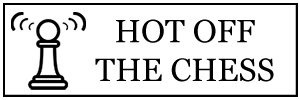
With Magnus Carlsen’s win over Ian Nepomniachtchi in round seven of the Croatia Grand Chess Tour, only one player remained, who had an unbeaten record over the World Champion. Ding Liren, of China, has managed to split the point with Magnus in each of their seven encounters so far. This made the fact that Ding would be Carlsen’s next opponent after Nepomniachtchi, very interesting.
Ding took White in the game, which took the form of an Open Catalan. The Chinese player was able to obtain good play, with a very advanced passed pawn on the c-file. However, Norway’s finest was not hanging about on the Queenside either. He was at least on terms upon White’s 17.Nd2, as the diagram, below, shows.
And it was here that Magnus Carlsen decided to spice things up, with 17…g5(!). I think it is fair to say that not many chess players would consider playing this move. I certainly wouldn’t — not that that should necessarily mean anything, of course. Though the move has its merits, (hitting the bishop on f4, which is guarding White’s advanced passed pawn on c7), pushing pawns infront of my King like this, goes against my grain. I think it goes against most of what we are taught when learning to play chess, actually.
To Magnus Carlsen, however, there are no rules. He has shown this throughout his career and is reaffirming it with his most recent play. It has to be remembered, that it was just over half a year ago, during his World Title defence in London, that his play seemed lack lustre and muted against Fabiano Caruana. Since then, he seems to have reinvented himself. Is he in the process of reinventing chess, too?
I think a lot of players would consider 17…g5 to be too much of a compromise to their own King, but not Carlsen, who is brimming with confidence and feeling secure with his position. And after Ding’s 18.Be5, Magnus continued 18…f6. And even though this forced the bishop to desert the pawn on c7, how many players would consider it worth putting so much air around their own King?
Such decisions can never be taken lightly, especially with so many pieces still on the board. However, in truth, we should all at least be considering them. Chess principles are solidly founded, but to every rule there is an exception. Magnus Carlsen is showing that he is not inhibited by these established principles and will judge positions on a case by case basis. This is a very exciting lesson to us all. And it is especially exciting for new players, who are learning chess by watching Magnus playing with this kind of inventive freedom.
Anyway, back to the game and after White’s 19.Bd4, Black netted the c7 pawn, with 19…Rxc7. This will have been very pleasing, because the bit was quite inhibiting where it was and had to go ASAP. The secondary issue to …Rxc7, was the threat towards White’s Queen, which became open to a discovery by Black’s knight on c5. This prompted Ding’s prudent 20.Qd1 — d1 being just about the only sensible square for the Queen, because White wants the c-file available for rooks.
The diagram above shows the position, which I personally think is quite hard to evaluate. In one way, it seems about equal and I suppose is a matter of preference. However, I also think that there is a strong case for giving Black a little edge. It would certainly be the side that I would choose. For me, Black has the better pieces and potential.
And perhaps this was also Ding’s evaluation, because he didn’t seem to play very positively from here. Perhaps this was because of the slightly cramped nature of his position, but he was a little complicit to Carlsen’s play. This allowed Black to exchange down into a very playable endgame.
Allowing Magnus Carlsen this type of position, was not the best thing for Ding. For starters, the bishop pair is rather significant, here, with their range and ability to control colour complexes making them more useful than the knight. And Ding was completely outplayed in this phase of the game. Magnus put on a steady grind and had the point in 59-moves.
With this result, Magnus Carlsen not only kept himself in the lead of the tournament, but removed the final one of his opponents with an unbeaten record against him. Not an insignificant fact, I am sure. Also not insignificant, was that it dropped Ding Liren down a place from joint-third.
In addition to Carlsen’s win over Ding, there were also wins for Wesley So against fellow American, Hikaru Nakamura and Anish Giri, who handed Shakhriyar Mamedyarov his third defeat of the tournament. I am not quite sure what is going on with the Azerbaijani, but he is a much better player that his performance in this tournament so far reflects. In the three rounds remaining, it is definitely damage limitation for him.
Standings after round 8 of 11:
Carlsen — 6.0
So — 5.5
Caruana, Nepomniachtchi, Aronian — 4.5
Ding Liren — 4.0
Anand, Giri, Karjakin, Vachier-Lagrave — 3.5
Nakamura, Mamedyarov — 2.5

